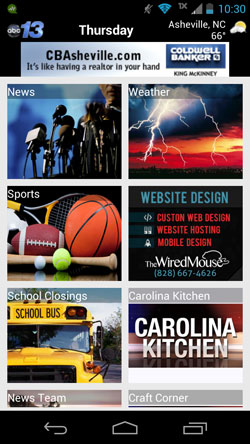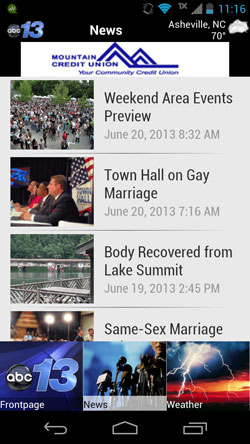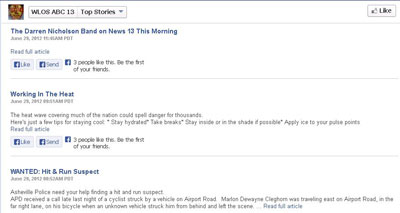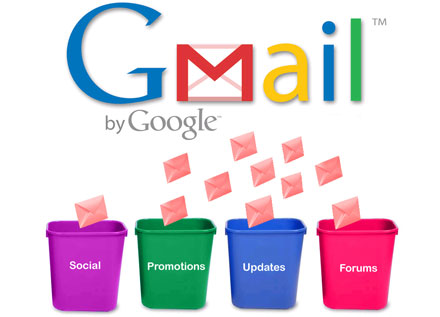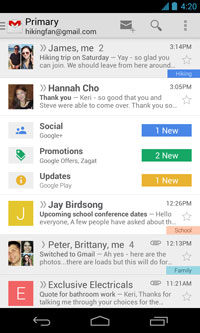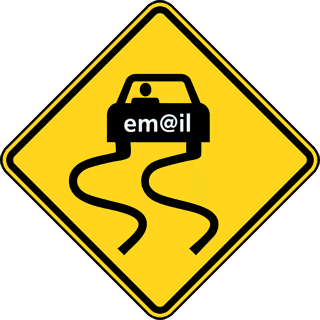 Every broadcast from the local news station includes a call to action for people to connect with them on Facebook and use their mobile app. The promise of immediate access to breaking stories is too good to refuse for news and weather junkies. Huge stories are a rarity in Western North Carolina except for weather related events. We jokingly say that if you don’t like the weather in the mountains to wait a minute and it will change. Over the last few weeks, violent storms have been rolling through the area making an app that gives early warning helpful.
Every broadcast from the local news station includes a call to action for people to connect with them on Facebook and use their mobile app. The promise of immediate access to breaking stories is too good to refuse for news and weather junkies. Huge stories are a rarity in Western North Carolina except for weather related events. We jokingly say that if you don’t like the weather in the mountains to wait a minute and it will change. Over the last few weeks, violent storms have been rolling through the area making an app that gives early warning helpful.
The first time alert I received was truncated. Every attempt to see the full message failed. I presumed that it was operator error. After weeks of inaccessible alerts, I decided that I would find the root of the problem. The last alert that appeared read, “BREAKING: The Asheville Police Department.” It came in at 10:13 AM.
Clicking it opened the home page of news channel:
Hmmmmm…maybe the alert is hiding under the News tab. Clicking on it opens a new page. There are two stories for this day. Both were posted too long ago to be considered “BREAKING.” Neither includes anything about the Asheville Police Department.
I am determined to find the breaking story. Visiting the news station’s webpage didn’t help. It had the same stories that were listed on the mobile app. Where else could I look? Perhaps they update their Facebook page with breaking stories? After all, they talk about it quite often and encourage viewers to check it.
A visit to the Facebook page found nothing about breaking news or the Asheville Police Department. It did have posts about a town hall meeting, weather questions, and watermelon flavored Oreo cookies.
A hidden tab on the Facebook page promises “Top Stories.” Surely it is there. An Asheville Police Department story appears when the tab is clicked. They are searching for a hit and run suspect. The story is dated June 29, 2012. This isn’t breaking news.
Periodically, I checked back to see if anything changed. The website didn’t change but Facebook had updates. The posts from the station that followed the breaking news alert included:
– What are your plans for the weekend?
– Three posts about a local blood drive
– Vote for the Facebook fan of the week
Finally, at 3:40 PM, approximately five and a half hours after the breaking news alert arrived, this post appeared:
The “On-Time” note on the post amuses me. Being a native Southerner, I am very aware that things move slower in the South but this takes slow to an unacceptable level!
Mobile apps and SMS texting are great tools for staying in touch with people on the move when they work. When they require the user to search for information, they don’t work. If you are using them (or thinking about it), follow these tips to keep users from getting frustrated with the process and your company:
- Test the process to insure that it is working correctly. Nothing stops forward motion faster than a landing page that doesn’t match the user’s expectation.
- Make the process and call to actions easy to understand and execute. People need to know what to do before they can do it.
- Simplify execution. A coupon code from JC Penny had 16 alphanumeric characters that had to be manually entered. The cashier got so frustrated after several erroneous entry attempts that she uttered a profanity!
- Design for small screens and large fingers. Clicking links that are close together is virtually impossible and extremely frustrating.
- Send people where you want them to go. Requiring multiple clicks to get to the right screen is guaranteed to frustrate users.
- Keep your social presence updated. If you have tabs or pages that aren’t being used, take them down.











